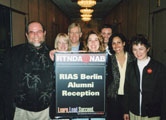U.S. Meeting of RIAS Fellows 2005
Las Vegas, April 16/17, 2005

About 100 alumni, station hosts and representatives of U.S. partner universities attended the reception on April 16 and the breakfast on April 17.
Guest speaker was Horst Stipp, Ph.D., Senior Vice President, Primary and Strategic Research, NBC Universal. He said:
We are faced with new technological developments in TV which will bring a lot of changes but also new opportunities. The most important changes will be the proliferation of channels and the increased use of Digital Video Recorders.
Media analyst Paul Kagan predicted that American TV consumers will migrate to near total on-demand viewing. This implies that commercial TV networks will have much less income since the TV viewers are assumed to use Digital Video Recorders to skip commercial breaks. In my view many reasons speak against these predictions and their impact on TV networks:
First of all it is much too early to draw firmconclusions. At this time, only about 7% of American consumers have DVRs. They are “early adopters” who are different from average viewers in many ways. Most Americans do not record many TV shows.
DVR owners love to record shows. Average viewers stay tuned during commercials about 90% of the time. The end of TV and TV advertising as we know it is highly unlikely. Even if DVRs are bought by half of US households, it will not mean the end of commercials. In the worst case we expect only 20 percent less viewing of commercials.
Another topic is the proliferation of TV channels. It is sometimes claimed that they will replace the major networks. As we already have over 200 channels in the US, we can study the impact on the audience. It is interesting to compare the ratings of the big networks with cable TV: the combined prime time news audience for the networks is approximately 30 million viewers in winter and 20 million in summer. Cable’s top news shows only attract an average of 2 million. While there has been a movement towards a greater variety of news sources on TV this is still quite small in comparison to the up to 10 million who daily tune in to NBC Nightly News.
My conclusion is that the new technologies do in fact change the media, including TV, but that change is usually much slower than predicted.
